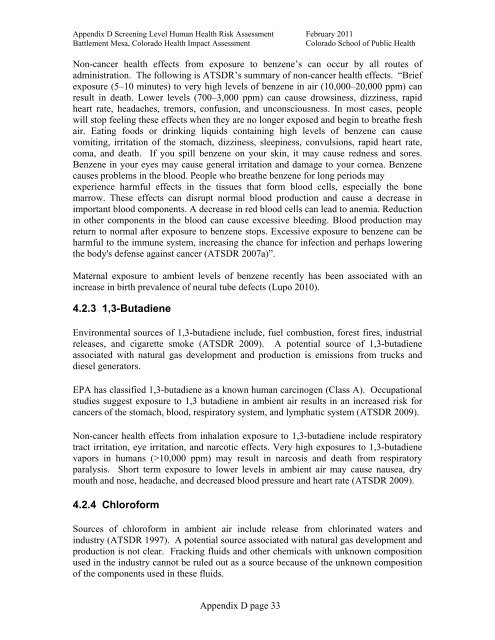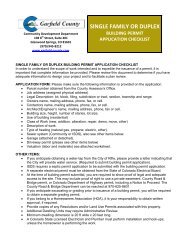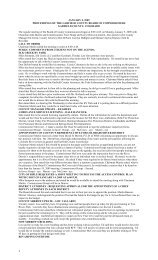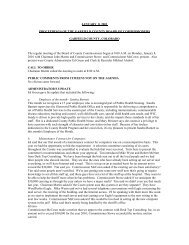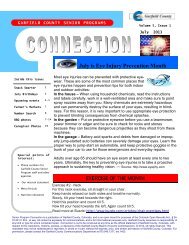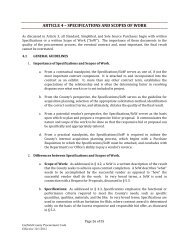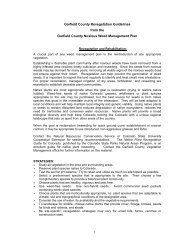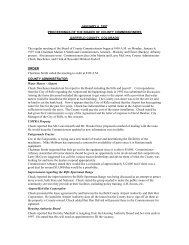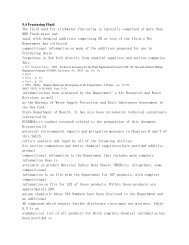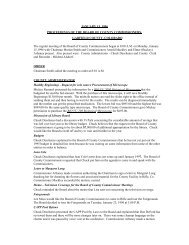Appendix D: Human Health Risk Assessment - Garfield County ...
Appendix D: Human Health Risk Assessment - Garfield County ...
Appendix D: Human Health Risk Assessment - Garfield County ...
You also want an ePaper? Increase the reach of your titles
YUMPU automatically turns print PDFs into web optimized ePapers that Google loves.
<strong>Appendix</strong> D Screening Level <strong>Human</strong> <strong>Health</strong> <strong>Risk</strong> <strong>Assessment</strong> February 2011<br />
Battlement Mesa, Colorado <strong>Health</strong> Impact <strong>Assessment</strong> Colorado School of Public <strong>Health</strong><br />
Non-cancer health effects from exposure to benzene’s can occur by all routes of<br />
administration. The following is ATSDR’s summary of non-cancer health effects. “Brief<br />
exposure (5–10 minutes) to very high levels of benzene in air (10,000–20,000 ppm) can<br />
result in death. Lower levels (700–3,000 ppm) can cause drowsiness, dizziness, rapid<br />
heart rate, headaches, tremors, confusion, and unconsciousness. In most cases, people<br />
will stop feeling these effects when they are no longer exposed and begin to breathe fresh<br />
air. Eating foods or drinking liquids containing high levels of benzene can cause<br />
vomiting, irritation of the stomach, dizziness, sleepiness, convulsions, rapid heart rate,<br />
coma, and death. If you spill benzene on your skin, it may cause redness and sores.<br />
Benzene in your eyes may cause general irritation and damage to your cornea. Benzene<br />
causes problems in the blood. People who breathe benzene for long periods may<br />
experience harmful effects in the tissues that form blood cells, especially the bone<br />
marrow. These effects can disrupt normal blood production and cause a decrease in<br />
important blood components. A decrease in red blood cells can lead to anemia. Reduction<br />
in other components in the blood can cause excessive bleeding. Blood production may<br />
return to normal after exposure to benzene stops. Excessive exposure to benzene can be<br />
harmful to the immune system, increasing the chance for infection and perhaps lowering<br />
the body's defense against cancer (ATSDR 2007a)”.<br />
Maternal exposure to ambient levels of benzene recently has been associated with an<br />
increase in birth prevalence of neural tube defects (Lupo 2010).<br />
4.2.3 1,3-Butadiene<br />
Environmental sources of 1,3-butadiene include, fuel combustion, forest fires, industrial<br />
releases, and cigarette smoke (ATSDR 2009). A potential source of 1,3-butadiene<br />
associated with natural gas development and production is emissions from trucks and<br />
diesel generators.<br />
EPA has classified 1,3-butadiene as a known human carcinogen (Class A). Occupational<br />
studies suggest exposure to 1,3 butadiene in ambient air results in an increased risk for<br />
cancers of the stomach, blood, respiratory system, and lymphatic system (ATSDR 2009).<br />
Non-cancer health effects from inhalation exposure to 1,3-butadiene include respiratory<br />
tract irritation, eye irritation, and narcotic effects. Very high exposures to 1,3-butadiene<br />
vapors in humans (>10,000 ppm) may result in narcosis and death from respiratory<br />
paralysis. Short term exposure to lower levels in ambient air may cause nausea, dry<br />
mouth and nose, headache, and decreased blood pressure and heart rate (ATSDR 2009).<br />
4.2.4 Chloroform<br />
Sources of chloroform in ambient air include release from chlorinated waters and<br />
industry (ATSDR 1997). A potential source associated with natural gas development and<br />
production is not clear. Fracking fluids and other chemicals with unknown composition<br />
used in the industry cannot be ruled out as a source because of the unknown composition<br />
of the components used in these fluids.<br />
<strong>Appendix</strong> D page 33


